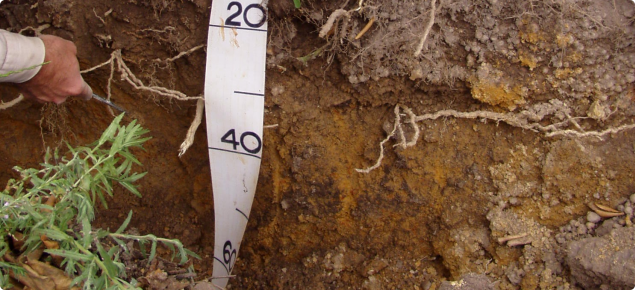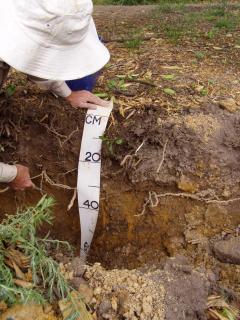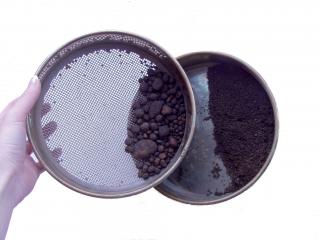Introduction
Water in the soil that is easily extracted by the plant is called Readily Available Water (RAW). To schedule irrigation with confidence that you are providing the crop with enough water you need to understand how much of the water your soil can hold that is available to your crop.
A plant's roots get the water it needs to grow and produce a crop from the surrounding soil. This water is held by the soil with increasing strength as the soil dries out. This makes it harder for the plant to get the water and therefore affects its growth.
The relationship between crop stress and the amount of water held in the soil is show in Figure 1. Some key terms relating to Readily Available Water (RAW) are field capacity and refill point:
- Field capacity is the maximum amount of water a soil can hold after drainage.
- Refill point is when the plant has used all readily available water.
Beyond refill point, as the soil dries out, the plant needs to work harder to extract water, stressing the crop. The area between field capacity and refill point is called Readily Available Water (RAW) — water in the soil that is easily extracted by the plant.
Unless you are trying to stress your crop (for example, with deficit-irrigated wine grapes), aim to maintain RAW at all times.
The amount of Readily Available Water varies with soil type, crop, rooting depth and irrigation system.
Follow these six steps to work out your crop’s RAW.
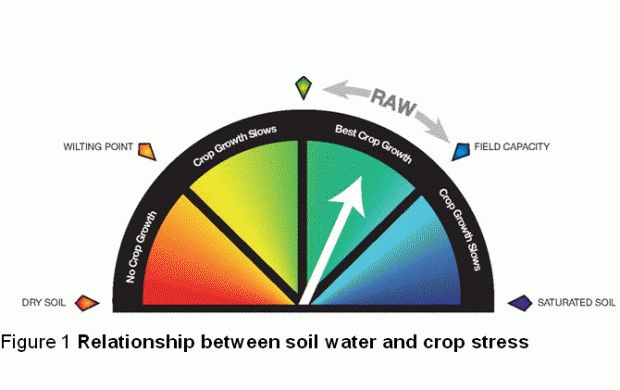
Steps in identifying Readily Available Water
Step 1: Dig a hole
Dig a hole within the root zone of your crop. For perennial crops, dig under the canopy in an area watered by the irrigation system. Try to dig to 1 metre or at least 30cm past the main root zone (where the fibrous roots are).
Step 2: Identify the effective root zone
The effective root zone is where the main mass of roots is found (see Figures 2 and 3). This is typically one to two-thirds of the depth of the deepest roots.
Some crops, such as irrigated pasture, citrus, bananas, avocados and low-chill stone fruit, develop a mass of shallow roots with only a few roots penetrating deeper into the soil.
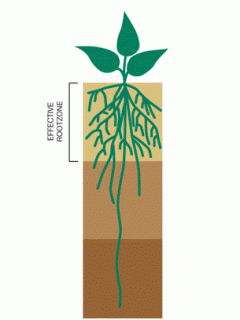
Step 3: Identify different soil layers
If you have different soil layers within the effective root zone measure the depth of each of these in metres.
Step 4: Identify gravel/stone in each layer
Stone and gravel reduce the amount of water that can be held by a soil. A very stony soil will hold much less water than the same soil without stones.
Grab three good handfuls of soil and using a 2mm sieve remove all stone and gravel (Figure 4). Place the pile of stones and gravel next to the pile of soil and visually estimate the proportions of each (for example, 60% stone and 40% soil).
Step 5: Identify soil texture(s)
Identify the texture of each soil layer within the effective root zone. The amount of water held by a soil and available to a plant varies with texture (see Table 1). For example, a loamy soil can hold more readily available water than a sand.
Soil texture can be assessed in the field by the feel of a moist soil sample when worked between your thumb and forefinger (Figure 5).
Step 6: Calculate RAW
- Identify the depth of the effective root zone.
- Identify the depth of different soil layers within the effective root zone.
- Determine the soil texture and percentage stone/gravel of each layer.
- Select the crop water tension group from Table 1 and identify the RAW value for each soil texture layer (mm/m).
- Reduce the RAW figure(s) by the % stone/gravel in the soil.
- Multiply the thickness of each soil layer by its adjusted RAW value.
- Add up the RAW for each soil layer to obtain the total root zone RAW.
Example calculation
A citrus crop growing in a sandy loam soil containing 20% stone, with an effective root depth of 0.3m and a strategy to irrigate at ‑40kPa would have the following calculations:
From Table 1, the RAW for a sandy loam soil at ‑40kPa = 60mm/m.
As the soil contains 20% stone, reduce the RAW by 20%. To do this, multiply by 0.8.
Adjusted RAW = 60mm/m x 0.8 = 48mm/m.
Hence, for a rooting depth of 0.3m:
Total root zone RAW = 48mm/m x 0.3m = 14.4mm.
If your irrigation system wets the entire cropped area, use this figure (RAW mm) to schedule irrigations. If you irrigate with a drip or micro-spray system that does not wet the entire cropped area, you need to convert RAW mm to RAW litres. See Converting Readily Available Water to litres for drip irrigation.
| Water tension (0kPa at saturation point) | To –20kPa | To –40kPa | To –60kPa | To –100kPa |
|---|---|---|---|---|
| Water-sensitive crops such as vegetables and some tropical fruits | Most fruit crops and tablegrapes, most tropical fruits | Lucerne, perennial pastures, crops such as maize and soybeans, wine grapes (except where partial root zone drying is being practised on wine grapes) | Annual pastures and hardy crops such as cotton, sorghum and winter crops | |
| Soil texture | Readily Available Water (mm/m) | |||
| Sand | 30 | 35 | 35 | 40 |
| Loamy sand | 45 | 50 | 55 | 60 |
| Sandy loam | 45 | 60 | 65 | 70 |
| Loam | 50 | 70 | 85 | 90 |
| Sandy clay loam | 40 | 60 | 70 | 80 |
| Clay loam | 30 | 55 | 65 | 80 |
| Light clay | 25 | 45 | 55 | 70 |
Acknowledgements
This information replaces Farmnote 543 Calculating Readily Available Water by Helen Newman, published in 2012.

